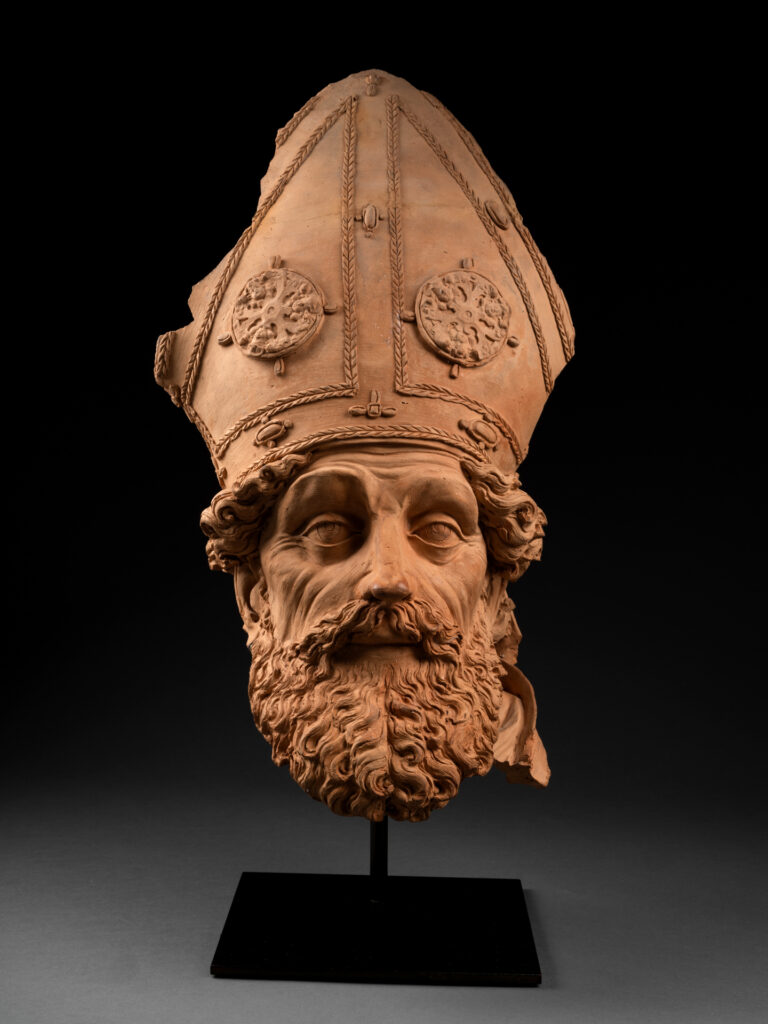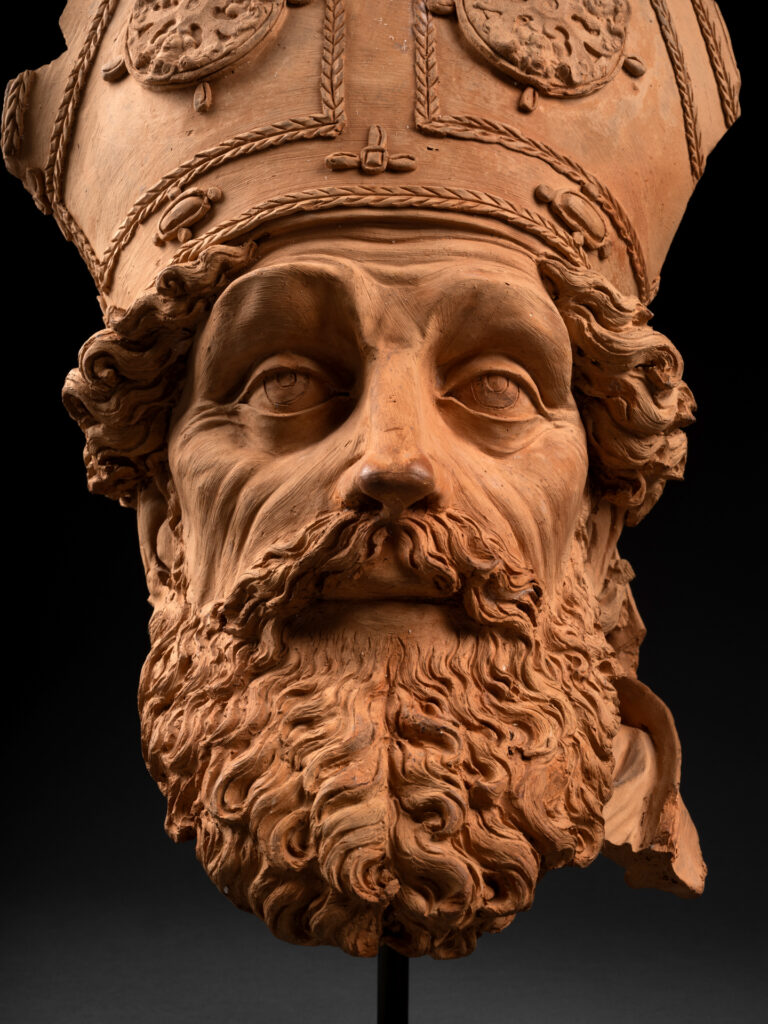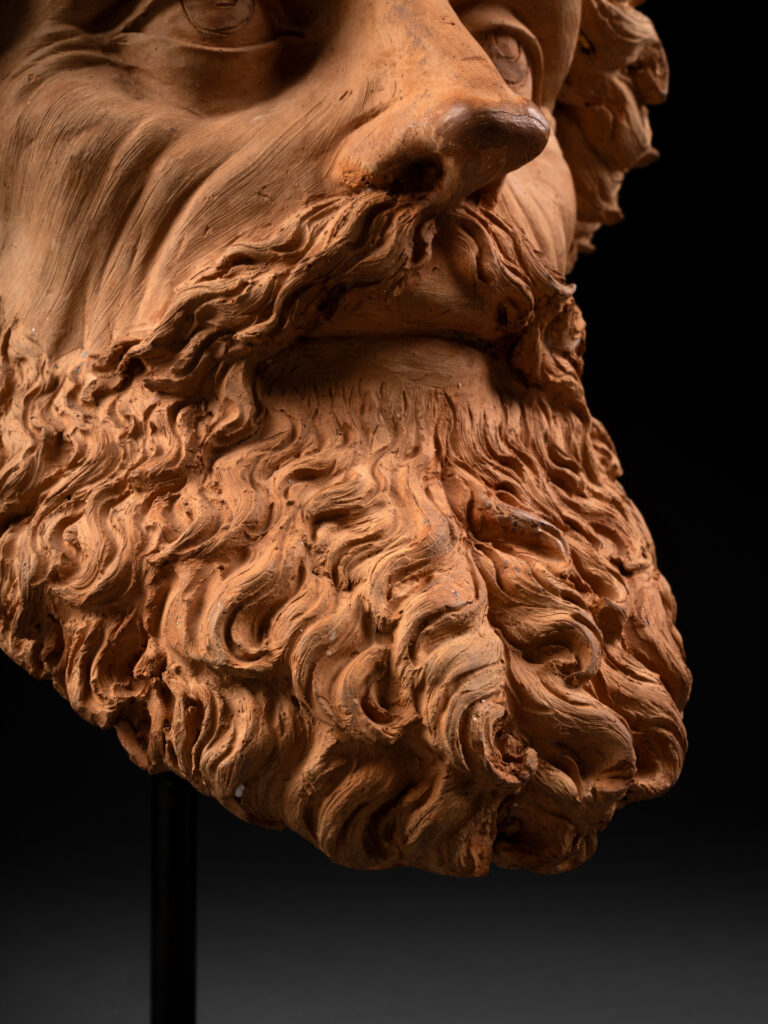This beautiful terracotta sculpture depicts a holy bishop, as suggested by his miter and long beard. In Christian iconography, several holy bishops are depicted with these attributes, but only two of them have hair of this length: Saint Augustine and Saint Ambrose.
The Fathers of the Churches are writers who lived in a state of sanctity during the first eras of Christianity, and who are authorities on matters of faith through their works and doctrine. They can be identified by attributes on their bodies: Saint Ambrose carries a beehive or a whip, while Saint Augustine holds a flaming heart in his hand. Our sculpture therefore does not allow precise identification of the figure. Nevertheless, the features of our bishop’s face are reminiscent of those used by artists to depict Saint Ambrose. In the early 17th century, the Flemish painter Matthias Stomer (1600-1650) produced several paintings depicting the holy bishop with elements similar to our terracotta head. It shows him as wrinkled, but not as an old man with pretty curls and a full head of hair and beard. Slightly chubby, the saint has a concentrated look in his eyes. The most representative feature is the bishop’s nose, long and very straight with narrow nostrils.
The Re.s.Artes laboratory carried out a thermoluminescence test on our terracotta, proving that it was dated between 1550 and 1650. During this period, the Liguria-Emilia region was home to a large number of terracotta sculptors. This very fragile material was kept for centuries in climates protected from humidity. Among the most famous works of this type is the Head of an Old Man by the Bolognese artist Guido Reni (1575-1642), circa 1600-1603.
Our Head of a Saint Bishop is closer to the work of the Emilia-Romagna artist Antonio Begarelli (1499-1565), known as il Begarino, to whom we have chosen to attribute it. Born in Modena, he was active in the Po Valley and quickly became one of the most eminent artists of his time. He began his career in Modena alongside his master Giovanni dell’Abbate, father of the painter Niccolò dell’Abbate (1509-1571), whom Begarelli later trained in his studio. During this period, Modena’s churches were decorated with terracotta sculptures: some were grouped above the altars to replace the traditional paintings. The artist Guido Mazzoni (1450-1518) was the first to propose this type of ensemble with free, almost life-size figures. His masterpieces include the Contemplation of the Dead Christ, painted between 1485 and 1489 for the church of Sant’Antonio di Castello in Venice.
It was after Mazzoni’s death in 1518 that Begarelli became one of the leading terracotta sculptors in his region, for in the wake of this tragic event, he received numerous commissions. In 1522, he created the Madonna di Piazza, now in Modena’s municipal museum. Begarelli did not simply take over Mazzoni’s work, but proposed a more restrained artistic language, inspired by the great models of classical antiquity.
At the end of his life, Begarelli was a lay member of the Benedictine order, and as such produced numerous sculptures. Our Bishop’s Head is in the style of his late-career production, particularly his sculptures for the abbey church of San Benedetto Po. Bagarelli asserts his style and proves the greatness of his technique with sculptures featuring realistic details. His saints have beautiful beards with well-defined curls, and the artist doesn’t hesitate to mark their wrinkles. Their eyes are characterized by a pupil carved out of terracotta and covered by a thick upper lid.
Just before his death, Begarelli was working on the decoration of the abbey church of the Benedictine monastery of San Pietro in Modena, for which he began the altarpiece that he was unfortunately unable to complete. This exceptional work became his funeral mausoleum. This is the work most similar to our own, with holy bishops depicted as wrinkled old men whose spatial representation is meticulously studied. As a Benedictine sculptor, Il Begarino offers not only a technically advanced ensemble, but also a reflection of the position of the saints in relation to the monks’ perception, an experience that was to respond to the new prayer practice introduced by Ludovico Barbo (1381-1443).
Antonio Begarelli regularly introduces the cherubini motif in his works. They can be found sculpted alongside saints, as in his representations of Saint Benedict, but also as small ornaments, as on his mausoleum. This motif is also found as an ornament on the vestments of these saints, notably on the medallion of Saint Gemini of Modena on the altarpiece of San Pietro. The mitre on our bishop’s head features the same element, reinforcing the hypothesis of this attribution. What’s more, there’s no trace of polychrome decoration, and Begarelli chose monochrome in keeping with the Benedictine liturgy of the Modena Congregation.
Our sculpture depicts the character of Antonio Begarelli’s terracottas. By the end of his life, he had established himself as an artist who mastered his art and put it at the service of his faith and the buildings of his region. Our work takes up the characteristics of his late-career production, marked by classicism, a movement that affected all the arts from the 16th century onwards, combining the quest for perfect forms with the revival of the classical model, a dating reinforced by thermoluminescence analysis.




